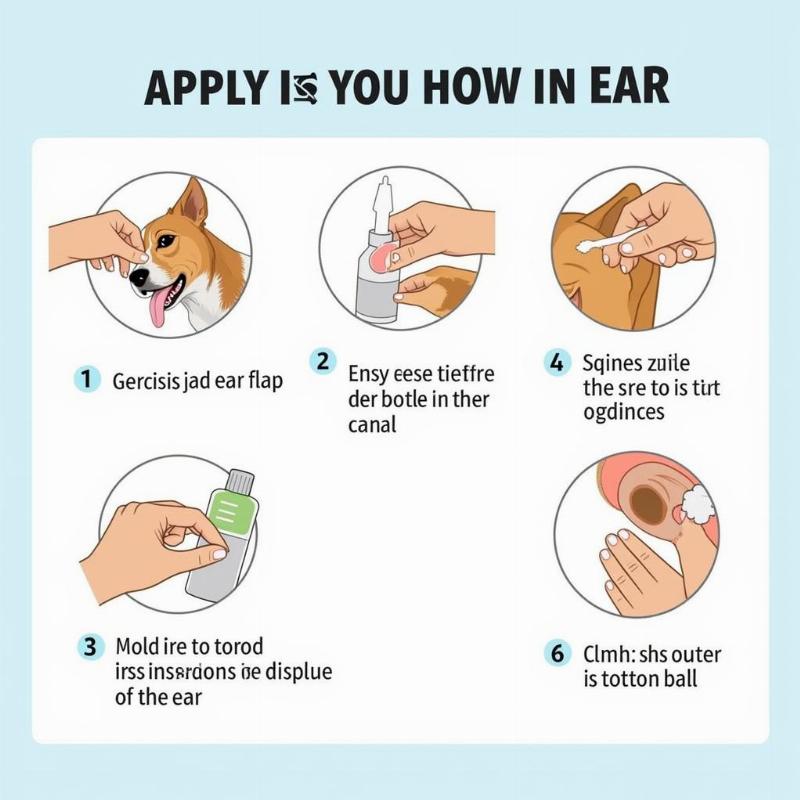Chlorhexidine ear flush is a common solution used to clean and treat dog ear infections. Understanding when and how to use this product is crucial for maintaining your dog’s ear health. This guide will delve into the uses, benefits, and potential risks of chlorhexidine ear flush, equipping you with the knowledge to care for your canine companion’s ears effectively.
Understanding Chlorhexidine for Dog Ear Care
Chlorhexidine is an antiseptic with antibacterial and antifungal properties, making it an effective treatment for various skin and ear infections in dogs. It works by disrupting the cell membranes of bacteria and fungi, preventing their growth and spread. Vets commonly prescribe chlorhexidine ear flush for conditions like otitis externa, commonly known as swimmer’s ear. It’s important to remember that while chlorhexidine is generally safe, it should only be used under the guidance of a veterinarian.
When to Use Chlorhexidine Ear Flush for Your Dog
Several signs indicate your dog might benefit from a chlorhexidine ear flush. Excessive scratching or pawing at the ears, head shaking, redness and swelling in the ear canal, a foul odor emanating from the ears, and dark-colored discharge are all potential symptoms of ear infection. However, self-diagnosing can be risky. It’s always best to consult a vet for a proper diagnosis and treatment plan before using chlorhexidine.
How to Administer Chlorhexidine Ear Flush
Your vet will demonstrate the correct technique, but here’s a general guide: Gently lift your dog’s ear flap and insert the prescribed amount of chlorhexidine ear flush into the ear canal. Massage the base of the ear for a few seconds to distribute the solution evenly. Allow your dog to shake its head to dislodge any debris or excess fluid. Clean the outer ear with a cotton ball or soft cloth, but avoid inserting anything into the ear canal.
 Applying Chlorhexidine Ear Flush
Applying Chlorhexidine Ear Flush
Potential Side Effects and Precautions
Chlorhexidine is generally well-tolerated, but some dogs may experience mild irritation or redness. Discontinue use and contact your vet if you notice any adverse reactions. Avoid getting the solution in your dog’s eyes. If this happens, rinse the eyes thoroughly with water. Never use chlorhexidine ear flush if your dog’s eardrum is ruptured, as this can cause further complications.
Preventing Ear Infections in Dogs
Regular ear cleaning can prevent infections. Ask your veterinarian about appropriate ear cleaning solutions and frequency. Keeping your dog’s ears dry, especially after swimming, is also essential. Certain breeds, such as those with floppy ears like Cocker Spaniels, are more prone to ear infections due to reduced airflow. Paying extra attention to these breeds’ ear hygiene is crucial.
Conclusion
Chlorhexidine ear flush can be a valuable tool in managing dog ear infections. However, it’s essential to consult your veterinarian for a proper diagnosis and treatment plan. Following their instructions and understanding the proper administration techniques and potential side effects ensures the safe and effective use of this medication, helping to keep your furry friend’s ears healthy and happy.
FAQ
- How often should I use chlorhexidine ear flush on my dog? Your vet will determine the frequency based on your dog’s specific condition.
- Can I use chlorhexidine ear flush on puppies? Consult your vet before using any medication on puppies.
- What should I do if my dog’s ear infection doesn’t improve? Contact your vet immediately for further evaluation.
- Are there any natural alternatives to chlorhexidine ear flush? Discuss alternative treatment options with your vet.
- Can I buy chlorhexidine ear flush over the counter? While some concentrations are available over-the-counter, it’s best to use a veterinary-prescribed solution tailored to your dog’s needs.
- My dog hates having his ears cleaned. What can I do? Try making the experience more positive with treats and praise. Your vet can also provide tips on restraining your dog safely during ear cleaning.
- How can I tell if my dog’s eardrum is ruptured? Only a veterinarian can diagnose a ruptured eardrum. Do not attempt to examine the ear canal yourself.
Beautdogs.us: Your Trusted Source for Dog Care
Beautdogs.us is a leading dog lifestyle website dedicated to providing comprehensive and reliable information on all aspects of dog care, from breed-specific advice to expert veterinary insights. Whether you’re a first-time dog owner or a seasoned expert, Beautdogs.us offers valuable resources and expert guidance to help you navigate the joys and challenges of dog ownership. We connect you with the latest trends in pet care, best veterinary practices, and product recommendations, empowering you to make informed decisions for your furry companion. Contact us today for all your dog care needs! Email: [email protected], Phone: +1 501-555-7529.